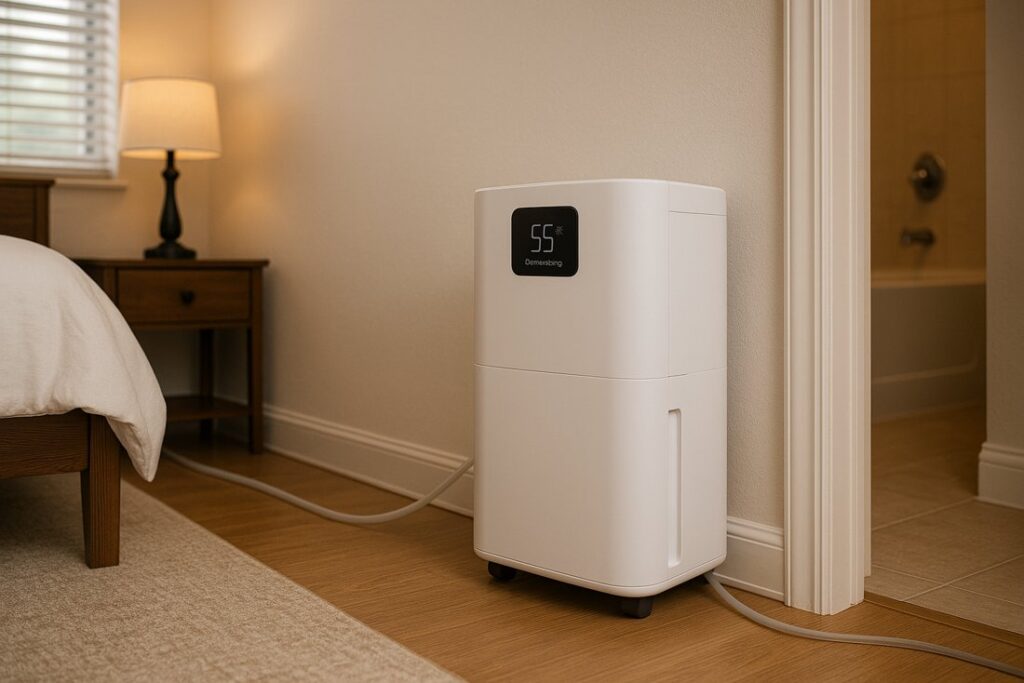Blog
Dehumidifier Vs AC: When You Need Extra Moisture Control

Florida homes ask a lot from cooling systems. Your AC cools and removes moisture, but some conditions push it past its comfort zone. This guide breaks down dehumidifier vs AC, shows how each handles moisture, and helps you decide when adding a dehumidifier makes sense. Along the way, you will see where FL-Air can help with setup, drain fixes, coil cleaning, or a clean dehumidifier install so your air feels crisp without overcooling.
Dehumidifier vs AC basics
Air conditioners dehumidify as a side effect of cooling. Warm indoor air passes over a cold evaporator coil, water condenses, and the condensate drains away. A dehumidifier is purpose-built to remove moisture first. It pulls air across a cold surface to collect water, then reheats the air slightly before sending it back into the home. In short, AC lowers the temperature and removes some water as it cools. A dehumidifier lowers humidity directly, even when you are not trying to drop the temperature.
If your AC struggles to maintain the set point and the house still feels humid, the issue may be mechanical, not a setting problem. FL-Air can clear a clogged condensate line, clean a dirty coil, or repair weak startup parts so your AC can dry the air the way it should.
Signs AC cannot keep up, and dehumidifier help is needed
- Indoor humidity stays above 55 percent for hours. Your thermostat shows the target temperature but the rooms still feel clammy.
- Short cycles with sticky rooms. The system cools quickly and shuts off before it has time to remove enough water.
- Cool bedrooms, damp living areas. At night, the temperature is fine, but the sheets feel damp, and the windows show a haze.
- Musty odor that returns. Coil and pan are clean, the drain is clear, yet the smell creeps back during mild weather.
- Seasonal homes and tight construction. Freshly sealed homes or snowbird arrivals often need targeted moisture control to feel right.
If you see these patterns after confirming fan Auto, a fresh filter, and clear returns, FL-Air can size and install a whole home dehumidifier and integrate it with your existing system.
dehumidifier vs AC in shoulder seasons
Spring and fall often bring warm but not hot afternoons with moderate temperatures at night. Your AC may not run long enough to remove moisture, which leaves rooms sticky even though the thermostat number looks fine. A dehumidifier bridges that gap. It trims humidity without forcing the whole house colder, so comfort lands in the 45 to 55 percent range with fewer complaints about chilly air.
Whole home dehumidifier vs portable units
Whole home dehumidifier
- Ties into the return duct or a dedicated return.
- Quiet operation and consistent RH across rooms.
- Drains to the same condensate path with an overflow safety.
- Controlled by its own humidistat or integrated with the thermostat.
FL-Air can install the unit, route a tidy drain with a cleanout, and set control logic so it runs only when needed.
Portable dehumidifier
- Lower upfront cost and quick to place.
- Works for a single room or trouble area.
- Requires manual bucket emptying or a nearby drain.
- Adds a little heat to the room while it runs.
FL-Air can help you pick a correct size and show you where to place it if you only need spot control.
Dehumidifier vs AC energy reality
Lowering humidity lets you hold a slightly warmer temperature and still feel comfortable. Many homeowners find that 75 degrees at 50 percent RH feels better than 72 at 60 percent. That shift trims runtimes and reduces the urge to chase the thermostat. A properly sized whole home dehumidifier also avoids the constant cycling that portable units often suffer in large spaces. If your AC is running constantly or short cycling, let FL-Air check airflow, coil cleanliness, and the run capacitor before you buy new equipment. Fixing the root cause often pays back faster than any add on.
What proper installation looks like
- Right capacity. Sized for square footage and typical indoor load so it does not short cycle.
- Clean airflow path. A dedicated return or a proper tie in to the existing return with a balancing damper.
- Smart control. Target indoor RH of 45 to 50 percent during occupied hours, relaxed slightly when away.
- Reliable drainage. A solid drain line with a trap where required, an accessible cleanout, and a float safety.
FL-Air handles the install, sets the target range, and validates temperatures and RH at a few rooms before we leave.
Maintenance that keeps results consistent
- Keep the AC fan on Auto so moisture can drain between cooling calls.
- Replace AC filters on time and seat the filter door tight to reduce dust in the pan.
- Rinse or replace the dehumidifier filter as the manufacturer recommends.
- Keep the combined drain path clear. If you notice gurgling or slow flow, FL-Air can clear the line and reset the float safety.
Dehumidifier vs AC: which should you choose
Choose AC only if your home holds 45 to 55 percent RH during normal cycles and comfort is steady. Choose dehumidifier plus AC if humidity stays high during mild weather, if rooms feel clammy at normal setpoints, or if you want to raise the cooling temperature without losing comfort. If you are undecided, FL-Air can measure indoor RH, air temperatures, and static pressure during a short visit and give you a straight answer.
Contact FL-Air Heating & Cooling
Ready to solve sticky rooms the simple way. Call 813-800-2665. FL-Air can set up your schedule, replace an inaccurate thermostat, clear a condensate line, clean coils, or handle full AC repair so your Florida settings work the way they should.








